
The Calpinae are a subfamily of moths in the family Erebidae described by Jean Baptiste Boisduval in 1840. This subfamily includes many species of moths that have a pointed and barbed proboscis adapted to piercing the skins of fruit to feed on juice, and in the case of the several Calyptra species of vampire moths, to piercing the skins of mammals to feed on blood. The subfamily contains some large moths with wingspans longer than 5 cm (2 in).

Emmelina monodactyla is a moth of the family Pterophoridae. It is found in Europe, Japan, central Asia, North Africa and North America.
Deinopa is a genus of moths of the family Erebidae erected by Francis Walker in 1856. The genus was previously classified in the subfamily Calpinae of the family Noctuidae.

Gabara is a genus of moths in the family Erebidae. The genus was erected by Francis Walker in 1866.
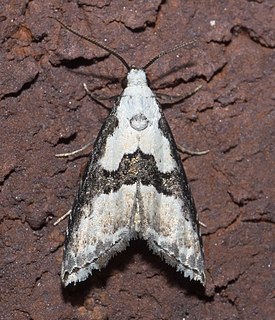
Nigetia is a monotypic moth genus in the family Erebidae. Its only species, Nigetia formosalis, the thin-winged algibelle or thin-winged owlet moth, has a scattered distribution in eastern North America from Ontario to Connecticut, south to Florida and Texas. Both the genus and the species were first described by Francis Walker in 1866.
Ossonoba is a monotypic moth genus in the family Erebidae. Its only species, Ossonoba torpida, is found in Darjeeling, India. Both the genus and the species were first described by Francis Walker in 1866.

Acronicta funeralis, the funerary dagger moth or paddle caterpillar, is a moth of the family Noctuidae. The species was first described by Augustus Radcliffe Grote and Coleman Townsend Robinson in 1866. It has a scattered distribution. It is found in North America from Manitoba to Nova Scotia, south to Maryland. It is also found in Georgia, Mississippi, Texas, and along the west-coast from California to British Columbia.
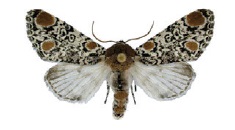
Harrisimemna trisignata, or Harris's three spot, is a moth of the family Noctuidae. The species was first described by Francis Walker in 1856. It is found in North America from Ontario, Quebec, New Brunswick, Nova Scotia, Newfoundland and Labrador, Alberta and Saskatchewan, south to Arizona. In the United States it has been recorded in Maryland, Pennsylvania, Wisconsin, Georgia, Illinois, Indiana, Iowa, New York, Ohio, Oklahoma, Tennessee, Texas and Virginia.

Idia rotundalis, the chocolate idia or rotund idia moth, is a litter moth of the family Erebidae. The species was first described by Francis Walker in 1866. It is found from southern Canada to Florida and Texas.

Scopula junctaria, the simple wave, is a moth of the family Geometridae. The species was first described by Francis Walker in 1861. It is found in the whole of Canada and the northern United States, south to Maryland, Arizona, and California.

Timandra amaturaria, the cross-lined wave moth or cobra inchworm, is a species of moth of the family Geometridae. The species was first described by Francis Walker in 1866. It is found in the US from Massachusetts to Florida, west to Texas and north to Wisconsin.

Loxostege commixtalis, the alfalfa webworm, is a species of moth in the family Crambidae. It was described by Francis Walker in 1866. It is found in Fennoscandia, Estonia and northern Russia. It is also found in North America, where it ranges from Nova Scotia and Newfoundland and Labrador west to the Yukon.

Banisia myrsusalis, the sapodilla borer or sapota midrib folder, is a species of moth of the family Thyrididae. It was described by Francis Walker in 1859 and is found in North America, Brazil, Australia, southern Asia and Africa.
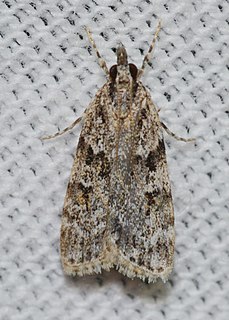
Scoparia biplagialis, the double-striped scoparia moth, is a moth in the family Crambidae. It was described by Francis Walker in 1866. It is found in North America, where it has been recorded from Alabama, Alaska, Alberta, British Columbia, California, Colorado, Florida, Georgia, Illinois, Indiana, Kentucky, Maine, Manitoba, Maryland, Massachusetts, Michigan, Minnesota, Montana, New Brunswick, New Hampshire, New Jersey, New York, North Carolina, North Dakota, Nova Scotia, Ohio, Ontario, Oregon, Pennsylvania, Quebec, Tennessee, Virginia, Washington, West Virginia and Wisconsin.

Arugisa latiorella, or Watson's arugisa moth, is a moth in the family Erebidae. The species was first described by Francis Walker in 1863. The species is found in North America, where it has been recorded from Florida to Texas, north to Kansas and Maryland.

Metalectra quadrisignata, the four-spotted fungus moth, is a species of moth in the family Erebidae. It is found in North America, where it has been recorded from Arizona, Florida, Georgia, Indiana, Iowa, Kentucky, Louisiana, Maine, Maryland, Massachusetts, Michigan, New Brunswick, New Hampshire, New Jersey, North Carolina, Ohio, Oklahoma, Pennsylvania, Quebec, South Carolina, Tennessee, Texas, Virginia, West Virginia and Wisconsin. The species was described by Francis Walker in 1858.
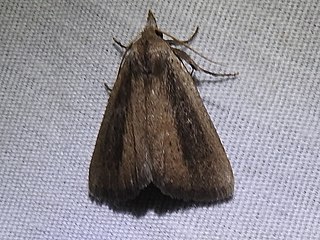
Gabara stygialis is a species of moth in the family Erebidae. It is found in North America.
Gabara gigantea is a species of moth in the family Erebidae. It is found in North America.
Gabara obscura is a species of moth in the family Erebidae. It is found in North America.
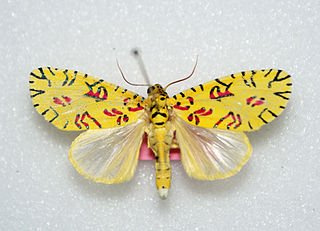
Mazuca strigicincta, the Pikachu moth, is a moth in the family Noctuidae found from Nigeria and Ghana down to northern Namibia and Mozambique.
















